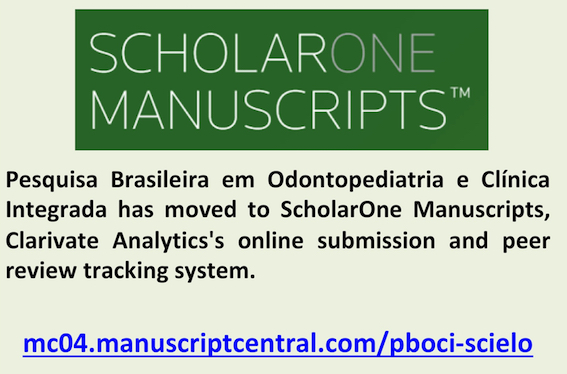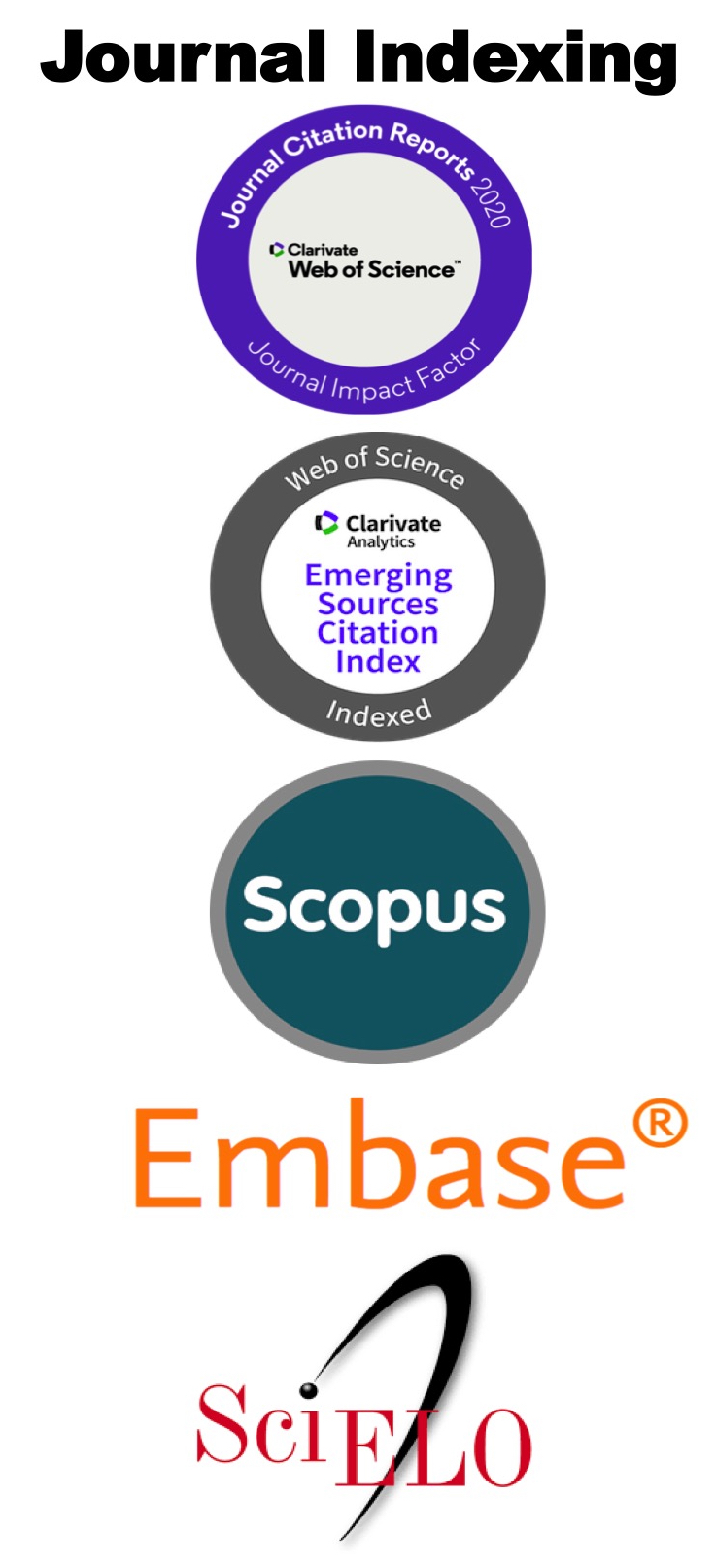Resin-Modified Glass Ionomer Nanocomposite: Subcutaneous Connective Tissue Response and Polymerization Shrinkage Resistance
Keywords:
Dental Materials, Glass Ionomer Cements, PolymerizationAbstract
Objective: To evaluate the in vitro polymerization shrinkage resistance and in vivo tissue response of the resin-modified glass ionomer cement (RMGIC) Ketac N100 after implantation in the subcutaneous connective tissue of isogenic mice. Material and Methods: A total of 90 isogenic BALB/c mice were randomly distributed into nine groups, with each group receiving an implant of one of the following materials: ChemFil, Ketac N100, Compoglass, and Filtek Z350, as well as empty tubes serving as controls. The in vitro polymerization shrinkage was evaluated using Ultralux with an irradiance of 480mW/cm², while in vivo tissue response was assessed through histological examination of tissue samples at 7, 21, and 63 days post-implantation. Statistical analysis was performed using ANOVA with an F-test, adopting a significance level of 5% and using Tukey's test for multiple comparisons. Results: Compoglass and Filtek Z350 exhibited similar levels of polymerization shrinkage, with no significant differences between them. Ketac N100 demonstrated polymerization shrinkage stress comparable to Filtek Z350 resin, indicating its performance is closer to composite resin than conventional glass ionomer. The histological analysis of the in vivo tissue response revealed that Ketac N100 had a favorable biocompatibility profile, similar to ChemFil and Filtek Z350, with no significant adverse tissue reactions. Conclusion: Ketac N100 exhibited a favorable tissue response and intermediate polymerization shrinkage, closer to composite resins than conventional glass ionomers. Both in vitro and in vivo analyses demonstrated the material's potential for clinical use.References
Sidhu SK, Nicholson JW. A review of glass ionomer cements for the dental clinic. J Funct Biomater 2016; 7(3):16. https://doi.org/10.3390/jfb7030016
Oliveira LA, Santos TA, Medeiros FCD. Color stability of glass ionomer cement in coloring solutions: integrative review. Research, Society and Development 2022; 11(3):11-25. https://doi.org/10.33448/rsd-v11i3.26190
Coldebella CR, Santos-Pinto L, Zuanon AC. Effect of ultrasonic excitation on the porosity of glass ionomer cement: A scanning electron microscope evaluation. Microsc Res Tech 2011; 74(1):54-57. https://doi.org/10.1002/jemt.20873
Deepalakshmi M, Poorni S, Miglani R, Rajamani I, Ramachandran S. Evaluation of the antibacterial and physical properties of glass ionomer cements containing chlorhexidine and cetrimide: An in-vitro study. Indian J Dent Res 2019; 21(4):552-556. https://doi.org/10.4103/0970-9290.74217
Rêgo HMC, Butler S, Santos MJC. Evaluation of the mechanical properties of three resin-modified glass-ionomer materials. Biomed Res Int 2022; 2:4690656. https://doi.org/10.1155/2022/4690656
Moshaverinia A, Roohpour N, Chee WWL, Schricker SR. A review of powder modifications in conventional glass ionomer dental cements. J Mater Chem 2011; 21(5):1319-1328. https://doi.org/10.1039/C0JM02309D
Upadhyay S, Rao A, Shenoy R. Comparison of the amount of fluoride release from nanofilled resin modified glass ionomer, conventional and resin modified glass ionomer cements. J Dent 2013; 10(2):134-140.
Upadhyay S, Rao A. Nanoionomer: Evaluation of microleakage. J Indian Soc Pedod Prev Dent 2011; 29(1):20-24. https://doi.org/10.4103/0970-4388.79919
Gerdolle DA, Mortier E, Droz D. Microleakage and polymerization shrinkage of various polymer restorative materials. J Dent Child 2008; 75(2):125-133.
International Organization for Standardization. Biological Evaluation of Medical Devices -Part 6: Biological evaluation of medical devices -- Part 6: Tests for local effects after implantation, ISO 10993-6:2007. Geneva, Switzerland: International Organization for Standardization; 2007.
Nelson Filho P, Silva LA, Leonardo MR, Utrilla LS, Figueiredo F. Connective tissue responses to calcium hydroxide-based root canal medicaments. Int Endod J 1999; 32(4):303-311. https://doi.org/10.1046/j.1365-2591.1999.00225.x
Ozbas H, Yaltirik M, Bilgic B, Issever H. Reactions of connective tissue to compomers, composite and amalgam root-end filling materials. Int Endod J 2003; 36(4):281-287. https://doi.org/10.1046/j.1365-2591.2003.00649.x
Pucinelli CM, Silva RABD, Borges LL, Borges ATDN, Nelson-Filho P, Consolaro A, et al. Tissue response after subcutaneous implantation of different glass ionomer-based cements. Braz Dent J 2019; 30(6):599-606. https://doi.org/10.1590/0103-6440202203562
Souza PP, Aranha AM, Hebling J, Giro EM, Costa CA. In vitro cytotoxicity and in vivo biocompatibility of contemporary resin-modified glass-ionomer cements. Dent Mater 2006; 22(9):838-844. https://doi.org/10.1016/j.dental.2005.10.002
Santos RL, Moura Mde F, Carvalho FG, Guênes GM, Alves PM, Pithon MM. Histological analysis of biocompatibility of ionomer cements with an acid-base reaction. Braz Oral Res 2014; 28. https://doi.org/10.1590/S1806-83242014.50000003
Condon JR, Ferracane JL. Reduced polymerization stress through non-bonded nanofiller particles. Biomaterials 2002; 23(18):3807-3815. https://doi.org/10.1016/s0142-9612(02)00099-6
Xie D, Brantley WA, Culbertson BM, Wang G. Mechanical properties and microstructures of glass-ionomer cements. Dent Mater 2000; 16(2):129-138. https://doi.org/10.1016/s0109-5641(99)00093-7
Yap AU, Mudambi S, Chew CL, Neo JC. Mechanical properties of an improved visible light-cured resin-modified glass ionomer cement. Oper Dent 2001; 26(3):295-301.
Condon JR, Ferracane JL. Assessing the effect of composite formulation on polymerization stress. J Am Dent Assoc 2000; 131(4):497-503. https://doi.org/10.14219/jada.archive.2000.0207
Downloads
Published
How to Cite
Issue
Section
License
Copyright (c) 2024 Pesquisa Brasileira em Odontopediatria e Clínica Integrada

This work is licensed under a Creative Commons Attribution-NonCommercial 4.0 International License.



